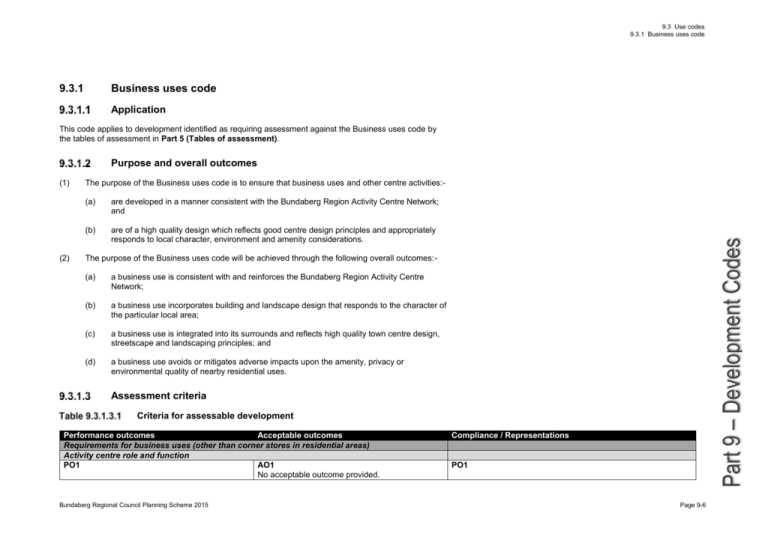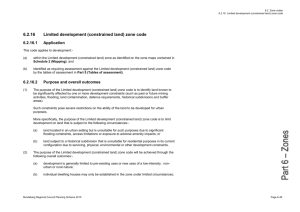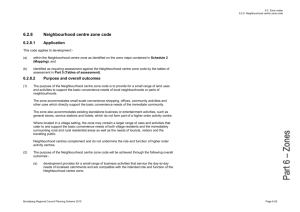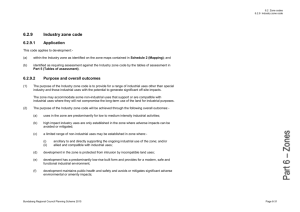Part 1 - Bundaberg Regional Council
advertisement

9.3 Use codes 9.3.1 Business uses code 9.3.1 Business uses code Application This code applies to development identified as requiring assessment against the Business uses code by the tables of assessment in Part 5 (Tables of assessment). Purpose and overall outcomes (2) The purpose of the Business uses code is to ensure that business uses and other centre activities:(a) are developed in a manner consistent with the Bundaberg Region Activity Centre Network; and (b) are of a high quality design which reflects good centre design principles and appropriately responds to local character, environment and amenity considerations. Part 9 – Development Codes (1) The purpose of the Business uses code will be achieved through the following overall outcomes:(a) a business use is consistent with and reinforces the Bundaberg Region Activity Centre Network; (b) a business use incorporates building and landscape design that responds to the character of the particular local area; (c) a business use is integrated into its surrounds and reflects high quality town centre design, streetscape and landscaping principles; and (d) a business use avoids or mitigates adverse impacts upon the amenity, privacy or environmental quality of nearby residential uses. Assessment criteria Criteria for assessable development Performance outcomes Acceptable outcomes Requirements for business uses (other than corner stores in residential areas) Activity centre role and function PO1 AO1 No acceptable outcome provided. Bundaberg Regional Council Planning Scheme 2015 Compliance / Representations PO1 Page 9-6 Part 9 – Development Codes 9.3 Use codes 9.3.1 Business uses code Performance outcomes Acceptable outcomes The business use is of a type, scale and intensity that is consistent with and reinforces the Bundaberg Region Activity Centre Network. Relationship of buildings to streets and public spaces PO2 AO2.1 The business use is in a building that:Buildings located in a main street or a core retail (a) clearly defines, frames or encloses the street area1 are built to the front boundary for all or most of and other useable public and semi-public open its length so as to create a continuous or mostly space; continuous edge. (b) has a front building line that is consistent with the existing or intended built form of the locality; AO2.2 and Buildings located in areas other than as specified in (c) has a positive streetfront address and helps AO2.1 are setback at least 6m from the street create or maintain an attractive and coherent frontage and main entrances front the street. local streetscape character. PO3 AO3 Car parking areas, service areas and driveways are The development provides for:located so as not to dominate the streetscape. (a) shared driveways; (b) rear access lanes; and (c) parking and service areas situated at the rear or the site or in a basement. PO4 AO4.1 The business use provides for footpaths, walkways Development located in a main street or a core retail and other spaces intended primarily for pedestrians area provides adequate and appropriate pedestrian to be comfortable to use and adequately sheltered shelter along the full length of the street frontage in from excessive sunlight and inclement weather. the form of an awning, colonnade, verandah or the like for the width of the verge. AO4.1 Development in areas other than as specified in AO4.1 no acceptable outcome provided. PO5 AO5.1 The business use is in a building which is designed Development provides for a minimum of 65% of the to create vibrant and active streets and public building frontage to a public street or other public spaces. space to present with clear or relatively clear windows and glazed doors. AO5.1 1 Compliance / Representations Provide a brief illustration of how your proposal complies with the relevant Acceptable outcome or a detailed analysis how compliance is achieved with the Performance outcome. AO2.1 Example representations: The site is located within the Bundaberg main street. Drawing No. ## demonstrates that the building is built to the front boundary consistent with adjoining building setbacks. AO2.2 Example representations: N/A as the site is located within the Bundaberg main street area. AO3 Click and provide your representations. AO4.1 Click and provide your representations. AO4.2 Click and provide your representations. AO5.1 Click and provide your representations. AO5.2 Click and provide your representations. AO5.3 Click and provide your representations. Note—for the purposes of this code, a ‘main street or core retail area’ refers to traditional street based areas within the historic town centres of townships and cities that incorporate a mix of retail, residential, community, and administration uses. Page 9-7 Bundaberg Regional Council Planning Scheme 2015 9.3 Use codes 9.3.1 Business uses code Performance outcomes Acceptable outcomes Compliance / Representations The ground storey level of any building in a main street or core retail area incorporates activities that are likely to foster casual, social and business interaction for extended periods such as shops, restaurants and the like. AO5.3 Development minimises vehicular access across active street frontages. AO6.1 Other than where located in a main street or a core retail area, site cover does not exceed:(a) 70% for that part of the development not exceeding 2 storeys in height; (b) 40% for that part of the development exceeding 2 storeys in height. AO6.2 Buildings are set back from street frontages:(a) in accordance with Acceptable Outcome AO2.1 and AO2.2 (as applicable) for that part of building up to 2 storeys in height; (b) at least 6m for that part of a building exceeding 2 storeys in height. AO6.1 Click and provide your representations. AO6.2 Click and provide your representations. Part 9 – Development Codes Building mass and composition PO6 The business use is in a building that enhances and complements the character and amenity of streets and neighbouring premises via a built form that:(a) maintains some area free of buildings at ground level to facilitate pedestrian movement and other functions associated with the building; (b) ensures access to attractive views and prevailing cooling breezes; and (c) reduces the apparent scale and bulk of buildings, to the extent practicable. AO6.3 Click and provide your representations. AO6.4 Click and provide your representations. AO6.5 Click and provide your representations. AO6.3 If not adjoining premises used for a residential activity or included in a residential zone, buildings are set back from other site boundaries as follows:(a) for that part of a building up to 2 storeys in height:(i) 0m if adjoining an existing blank wall or vacant land on an adjoining site; or (ii) at least 3m if adjoining an existing wall with openings on an adjoining site; (b) at least 4m for that part of a building exceeding 2 storeys in height. OR Bundaberg Regional Council Planning Scheme 2015 Page 9-8 9.3 Use codes 9.3.1 Business uses code Performance outcomes Acceptable outcomes Compliance / Representations If adjoining premises used for a residential activity or included in a residential zone, buildings are set back from other site boundaries as follows:(a) at least 3m for that part of a building up to 2 storeys or 8.5m in height; (b) at least 6m for that part of a building exceeding 2 storeys or 8.5m in height. Part 9 – Development Codes AO6.4 Any projection above the podium level outside the boundaries of the building envelope is limited to balconies that do not project more than 1.5m into the setback. AO6.5 All storeys of a building above the second storey have a plan area that does not exceed 1,000m² with no horizontal facade exceeding 45m in length. Building features and articulation PO7 The business use is in a building which:(a) provides visual interest through form and facade design; (b) provides outdoor or semi-enclosed public spaces that complement adjoining indoor spaces; (c) takes advantage of local climatic conditions in ways that reduce demand on non-renewable energy sources for cooling and heating; and (d) appropriately responds to the character and amenity of neighbouring premises. AO7.1 The building has articulated and textured facades that incorporates some or all of the following design features to create a high level of openness and visual interest, and provide shading to walls and windows:(a) pedestrian awning, colonnades, verandahs, balconies and eaves; (b) recesses, screens and shutters; (c) textural and material variation; (d) windows that are protected from excessive direct sunlight during warmer months. AO7.1 Click and provide your representations. AO7.2 Click and provide your representations. AO7.3 Click and provide your representations. AO7.2 The building is articulated and finished in a manner that positively responds to attractive and notable elements of adjacent buildings and the streetscape, such as continuity of colonnades, verandahs, balconies, eaves, parapet lines and roof forms. AO7.3 Page 9-9 Bundaberg Regional Council Planning Scheme 2015 9.3 Use codes 9.3.1 Business uses code Acceptable outcomes Compliance / Representations The building incorporates vertical and horizontal articulation such that no unbroken elevation is longer than 15m. PO8 AO8 PO8 Where the business use involves the development No acceptable outcome provided. Click and provide your representations. of a multi-storey building, the building is designed to:(a) display the functional differences between the ground level and the above ground level spaces; (b) have a top level and roof form that is shaped to provide a visually attractive skyline silhouette; and (c) effectively screen rooftop mechanical plants from view. Environmental management and amenity of residential premises PO9 AO9.1 AO9.1 The business use does not unreasonably impact Undesirable visual, noise and odour impacts on Click and provide your representations. upon the amenity or environmental quality of its public spaces and residential uses, are avoided or AO9.2 environs and especially any nearby residential reduced by:premises. (a) where appropriate, limiting the hours of Click and provide your representations. operation of the business use to maintain acceptable levels of residential amenity relative AO9.3 to the site context and setting; Click and provide your representations. (b) providing vehicle loading/unloading and refuse storage/collection facilities within enclosed service yards or courtyards; and (c) not locating site service facilities and areas along any frontage to a street or other public space. Part 9 – Development Codes Performance outcomes AO9.2 Where the business use requires the use of acoustic attenuation measures to mitigate adverse impacts on nearby sensitive land uses, such measures are designed and constructed to be compatible with the local streetscape. AO9.3 If adjoining premises are used for a residential activity or included in a residential zone, buildings are sited and designed to mitigate adverse microBundaberg Regional Council Planning Scheme 2015 Page 9-10 9.3 Use codes 9.3.1 Business uses code Part 9 – Development Codes Performance outcomes Acceptable outcomes Compliance / Representations climatic impacts from overshadowing or wind tunnelling. PO10 AO10.1 AO10.1 The business use maintains the reasonable privacy Where the development is adjacent to an existing or Click and provide your representations. and amenity of residential premises such that the approved building containing residential uses, the use of indoor and outdoor living areas by residents reasonable privacy and amenity of such uses is is not unreasonably diminished. maintained by:(a) siting and orienting buildings to minimise the likelihood of overlooking occurring; (b) having windows and outdoor areas, (including balconies and terraces) located and designed so that they do not look into dwellings or rooming units; and (c) incorporating screening over building openings. Safety and security PO11 AO11 PO11 Development contributes to a safe and secure No acceptable outcome provided. Click and provide your representations. pedestrian environment by:(a) allowing casual surveillance to and from the street and other public spaces; (b) orienting the upper level windows so that they overlook the street and other public spaces; (c) ensuring entrances to businesses are clearly defined and visible from the street, car parking areas and pathways; (d) providing adequate lighting of entrances; (e) providing clear sightlines for pathways and routes; (f) presenting an active face to the street by generous provision of windows and openings and avoiding the use of security shutters; (g) using external building materials and finishes that are robust and durable; and (h) avoidance of blank exposed walls to discourage vandalism. Requirements for corner stores in residential areas PO12 AO12.1 AO12.1 Where the business use involves the establishment The corner store is located on a site that:Click and provide your representations. of a corner store in a residential area, the corner (a) has access and frontage to a collector street or AO12.2 store:higher order road; or (a) is appropriately located in the residential area (b) is adjacent to a community activity or an Click and provide your representations. taking account of the size and configuration of existing non-residential use. Page 9-11 Bundaberg Regional Council Planning Scheme 2015 9.3 Use codes 9.3.1 Business uses code Performance outcomes the neighbourhood and the location of other existing or approved retail facilities; and (b) is compatible with the scale and intensity of development in the neighbourhood. Acceptable outcomes AO12.2 The corner store is located on a site that is more than 400m radial distance from:(a) any existing shop; (b) any site with a current approval for a shop; or (c) any land included in a centre zone. Compliance / Representations AO12.3 Click and provide your representations. Part 9 – Development Codes AO12.3 Site cover for a corner store does not exceed 50%. Bundaberg Regional Council Planning Scheme 2015 Page 9-12







